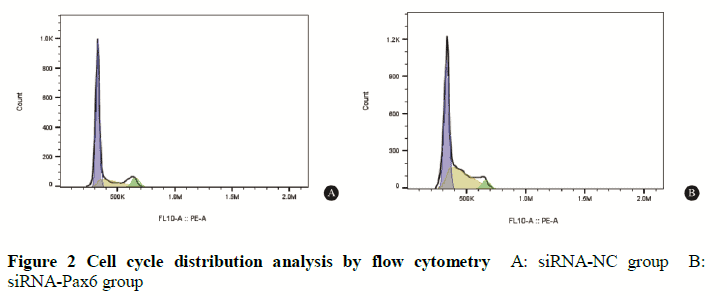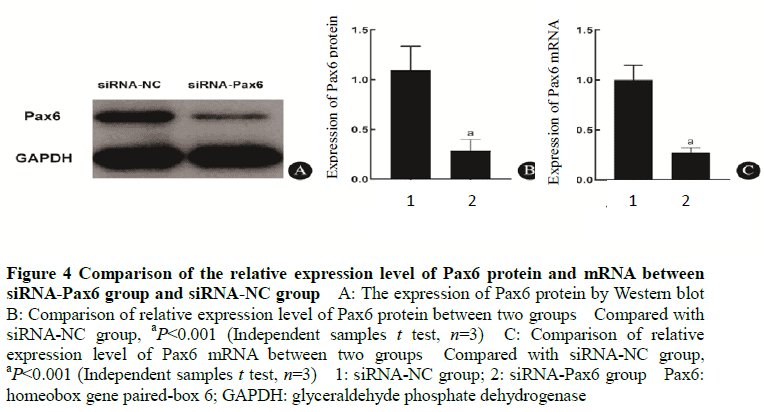Abstract [View PDF] [Read Full Text]
Objective
To explore the effect of knockdown of the homeobox gene paired-box 6 (Pax6) on the biological behavior and epithelial-mesenchymal transition (EMT) of human lens epithelial cells (LECs).
Methods
The SRA01/04 human LECs were divided into small interfering RNA-Pax6 (siRNA-Pax6) group transfected with siRNA-Pax6 and siRNA negative control (siRNA-NC) group transfected with disordered siRNA.Cell survival rate was detected by cell counting kit-8 method at 24, 48 and 72 hours after transfection.Cell cycle distribution and apoptosis were analyzed by flow cytometry at 48 hours after transfection.Migratory capability of cells was examined by cell scratch test at 24 hours after transfection.The mRNA relative expression levels of Pax6, α-crystallin A (CRYAA), α-crystallin B (CRYAB), Sox2, α-smooth muscle actin (α-SMA) and E-cadherin were detected by quantitative real-time PCR at 48 hours after transfection.The relative expression of Pax6 protein was detected by Western blot at 48 hours after transfection.
Results
There was a significant difference in cell survival rates at different time points between the two groups (Fgroup=4.776, P<0.05; Ftime=13.535, P<0.05). The cell survival rate of siRNA-Pax6 group was obviously lower than that of siRNA-NC group at 48 and 72 hours after transfection, and the differences were statistically significant (both at P<0.05). Compared with siRNA-NC group, the proportion of cells in G0/G1 phase was significantly increased and the proportion of cells in S phase was significantly reduced in siRNA-Pax6 group (t=9.971, -5.063; both at P<0.05). The cell migration rate of siRNA-Pax6 group was (19.73±6.07)%, which was lower than (70.56±2.97)% of siRNA-NC group, showing a statistically significant difference (t=-7.245, P<0.05). The relative expressions of Sox2 mRNA and α-SMA mRNA were lower, and the relative expression of E-cadherin mRNA was higher in siRNA-Pax6 group than siRNA-NC group, with statistically significant differences between them (t=-23.254, -5.294, 6.062; all at P<0.01). The relative expression of CRYAA mRNA and CRYAB mRNA was significantly higher in siRNA-Pax6 group than siRNA-NC group, and the differences were statistically significant (t=5.521, 8.270; both at P<0.01). The relative expressions of Pax6 mRNA and protein in siRNA-Pax6 group were 0.27±0.01 and 0.24±0.05, respectively, which were both lower than 1.00±0.05 and 1.14±0.10 in siRNA-NC group, showing statistically significant differences (t=-14.456, -4.458; both at P<0.001).
Conclusions
Silence of Pax6 can suppress the proliferation and EMT of human LECs and enhance the expression of crystallin.
Key words:
Figures and tables









Contributor Information
Department of Ophthalmology, The Sixth Affiliated Hospital of Sun Yat-sen University, Guangzhou 510655, China
Department of Ophthalmology, The Sixth Affiliated Hospital of Sun Yat-sen University, Guangzhou 510655, China
Department of Ophthalmology, The Sixth Affiliated Hospital of Sun Yat-sen University, Guangzhou 510655, China
Department of Ophthalmology, The Sixth Affiliated Hospital of Sun Yat-sen University, Guangzhou 510655, China
Department of Ophthalmology, The Sixth Affiliated Hospital of Sun Yat-sen University, Guangzhou 510655, China
Department of Ophthalmology, The Sixth Affiliated Hospital of Sun Yat-sen University, Guangzhou 510655, China